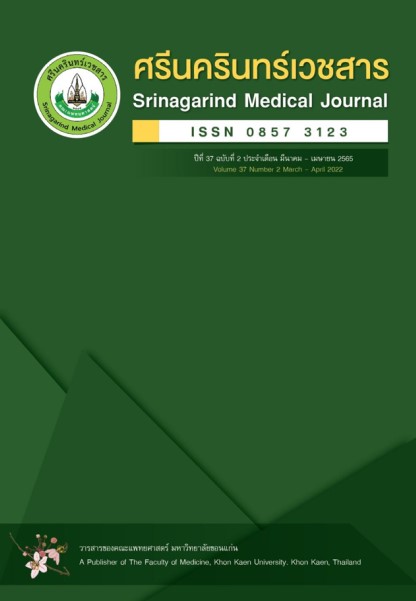คะแนนการทำนายทางคลินิกเพื่อทำนายการเกิดภาวะเยื่อบุช่องท้องอักเสบที่ไม่ตอบสนองต่อการรักษาในผู้ป่วยล้างไตทางช่องท้อง
Abstract
A Clinical Prediction Score to Predict Refractory Peritonitis in Peritoneal Dialysis Patients
บทคัดย่อ
หลักการและวัตถุประสงค์: การล้างไตทางช่องท้องชนิดต่อเนื่องมีภาวะแทรกซ้อนที่สำคัญคือ การติดเชื้อในเยื้อบุช่องท้อง (Peritoneal dialysis related peritonitis) ถ้าปริมาณเม็ดเลือดขาวในน้ำยาล้างไตมากกว่า 100 เซลล์ต่อลูกบาศก์มิลลิเมตร ภายหลังการรักษาเกิน 5 วัน เรียกภาวะนี้ว่า ภาวะเยื่อบุช่องท้องอักเสบที่ไม่ตอบสนองต่อการรักษา (refractory peritonitis) ยังไม่มีการทำเครื่องมือเพื่อใช้มาทำนายภาวะเยื่อบุช่องท้องอักเสบที่ไม่ตอบสนองต่อการรักษาในผู้ป่วยล้างไตทางช่องท้องมาก่อน ดังนั้นการศึกษานี้จึงมีวัตถุประสงค์ เพื่อสร้าง Clinical prediction score จากอาการทางคลินิกในช่วงต้นมาพยากรณ์การเกิดภาวะ refractory peritonitis
วิธีการศึกษา: การวิจัยติดตามแบบย้อนหลัง (retrospective cohort study) ในผู้ป่วยไตวายเรื้อรังที่ได้รับการล้างไตทางช่องท้องในโรงพยาบาลอุดรธานี และได้รับการวินิจฉัยว่ามีภาวะเยื่อบุช่องท้องอักเสบ ในช่วง 1 กรกฎาคม พ.ศ. 2559 ถึง 31 ธันวาคม พ.ศ. 2560 สร้างชุดตัวแปรทำนายด้วย multivariable logistic regression สร้างคะแนนความเสี่ยงด้วย Logistic coefficients ของตัวแปร สร้างคะแนนความเสี่ยงรายข้อ และคะแนนเสี่ยงรวม แล้วนำคะแนนกลับไปทำนาย Refractory peritonitis กำหนดระดับนัยสำคัญทางสถิติที่ α=0.05
ผลการศึกษา: พบเยื่อบุช่องท้องอักเสบทั้งหมด 395 ครั้ง เป็นภาวะเยื่อบุช่องท้องอักเสบที่ไม่ตอบสนองต่อการรักษาทั้งหมด 78 ครั้ง (ร้อยละ 19.8) ปัจจัยที่นำมาคิดคะแนนในวันที่ 3 ของการรักษาได้แก่ การมีภาวะทุพโภชนาการ, อาการปวดท้อง, อาการถ่ายเหลว ยังมีอาการน้ำยาขุ่น จำนวนเม็ดเลือดขาวในน้ำยาฟอกไต ≥ 1,000 เซลล์ ต่อลบ.มม., จำนวนเม็ดเลือดขาวในน้ำยาฟอกไต และ ≥ ร้อยละ 50 ของจำนวนเม็ดเลือดขาวในน้ำยาฟอกไตในวันที่ 1 ของการรักษา คะแนนการทำนายทางคลินิกสามารถทำนายการเกิดภาวะเยื่อบุช่องท้องอักเสบที่ไม่ตอบสนองต่อการรักษาได้ดีมี AuROC 0.95 (95% CI 0.92-0.97) ค่า Likelihood ratio of positive เท่ากับ 0.02 ในกลุ่มเสี่ยงต่ำ 1.5 ในกลุ่มเสี่ยงปานกลาง และ 19.3 ในกลุ่มเสี่ยงสูง
สรุป: คะแนนการทำนายทางคลินิกเพื่อทำนายการเกิดภาวะเยื่อบุช่องท้องอักเสบที่ไม่ตอบสนองต่อการรักษาสามารถช่วยในการประเมินและดูแลผู้ป่วยล้างไตทางช่องท้องที่เกิดภาวะเยื่อบุช่องท้องอักเสบ
คำสำคัญ: การล้างไตทางช่องท้อง; ภาวะเยื่อบุช่องท้องอักเสบ; ไตวายเรื้อรังระยะสุดท้าย; ไม่ตอบสนองต่อการรักษา; การทำนายทางคลินิก
Abstract
Background and Objective: Peritoneal dialysis related peritonitis is the major complication in peritoneal dialysis patients. After 5 days of proper treatment, leukocytes in the dialysate are still more than 100 cells/ mm3 is called refractory peritonitis. No clinical tools have been made to predict refractory peritonitis. This study aimed to develop the clinical prediction score to predict refractory peritonitis in peritoneal dialysis patients.
Method: This study was retrospective cohort study in peritoneal dialysis patients who were diagnosed with peritonitis from July 2016 to December 2017 in Udon Thani Hospital. Multivariate logistic regression analysis was used to develop the clinical prediction factors and transformed into scores by logistic coefficients and created an associated risk score and total risk score.
Results: 395 episodes of peritonitis were included in analysis; 78 episodes (19.8%) were refractory peritonitis. The prognostic factors that include in score were malnutrition, abdominal pain on the 3rd day of treatment, diarrhea on the 3rd day of treatment, still cloudy effluent on the 3rd day of treatment, white blood cells in dialysate on the 3rd day of treatment ≥ 1,000 cells/mm3, white blood cells in dialysate on the 3rd day of treatment ≥ 50% of white blood cells in dialysate on the 1st day of treatment. The prediction score had good performance to predict refractory peritonitis with an AuROC of 0.95 (95% CI 0.92-0.97). The Likelihood ratio of positive was 0.02 in the low-risk category, 1.5 in the moderate-risk category and 19.3 in the high-risk category.
Conclusion: A clinical prediction score to predict refractory peritonitis may help the clinician to monitor and care in peritoneal dialysis patients with peritonitis.
Keywords: Peritoneal Dialysis; peritonitis; end-stage renal disease; refractory; clinical prediction rule


